The official currency of Cambodia is the Cambodian riel (KHR), which has been in use since 1980. However, the US dollar is also widely accepted throughout the country, particularly in tourist areas.
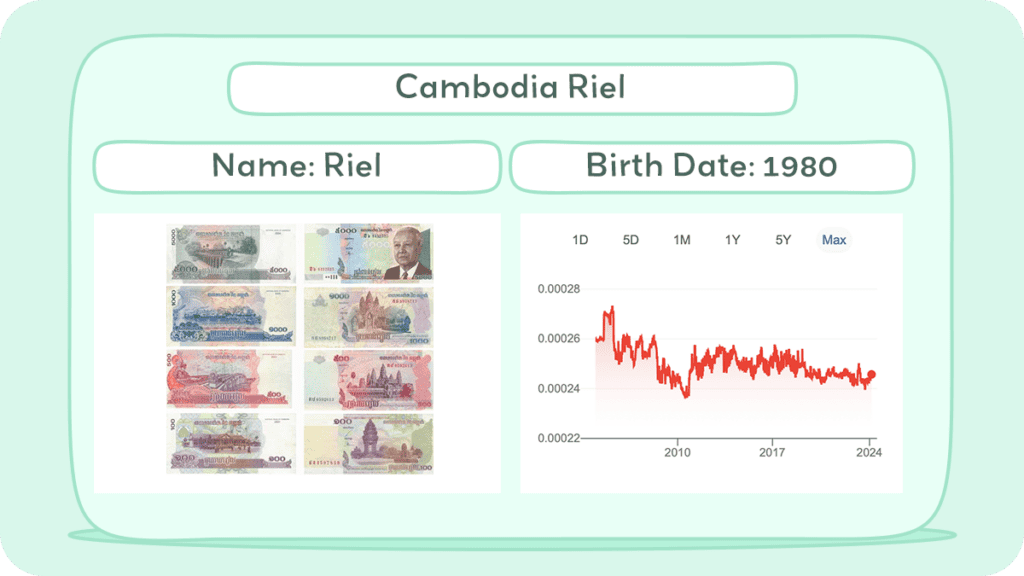
The Cambodian Riel, the official currency, has undergone two iterations since 1953 and was reintroduced in 1980. It maintains an informal fixed exchange rate with the US dollar, serving as a de facto currency.
In this article, we delve into the origins and current status of the Cambodian Riel, exploring its significance both domestically and in the international financial landscape. From its inception in 1953 to its various redesigns and denominations over the years, we aim to provide a comprehensive overview of the currency’s journey.
Historical Journey of Cambodia Currency
Cambodia has a rich and diverse history when it comes to currency. The country has used various forms of currency over the years, including metal money, paper notes, and coins. The country’s currency has also been influenced by various cultures, including Indian, Chinese, and French.
The first known currency used in Cambodia was metal money, which was used during the Funan Kingdom in the 1st century CE. The metal money was made of gold, silver, and bronze and was used for trading with neighboring countries. The use of metal money continued during the Chenla Kingdom and the Khmer Empire.
In the 19th century, Cambodia started using paper notes, which were introduced by the French. The first paper notes were introduced in 1859 and were called “piastres”. The piastres were later replaced by the “riels” in 1953 after Cambodia gained independence from France.
The riel has since become the official currency of Cambodia and is used for all transactions within the country. The riel is divided into smaller units called “sen” and “kak”. One riel is equal to 100 sen, and one sen is equal to 10 kak.
Over the years, the riel has gone through several changes. In 1975, the Khmer Rouge regime abolished the use of money in Cambodia. After the regime was overthrown, the riel was reintroduced in 1980. In 1995, the National Bank of Cambodia issued a new series of banknotes to replace the old ones.
Today, the riel is used in combination with the US dollar, which is widely accepted in Cambodia. The use of the US dollar has helped stabilize the economy in Cambodia and has made it easier for tourists to visit the country. However, the government is currently working towards de-dollarization, which would make the riel the sole currency used in the country.
History of Coins
In 1953, Cambodia minted aluminum 10, 20, and 50 centimes and sen coins, sized similarly to Laos’s att and South Vietnam‘s xu coins, excluding the holes present in Laos’s coins.
A planned 1 riel coin, approximately the size of a U.S. nickel and part of the United Nations’ Food and Agriculture Organization coin program, was never released due to the 1970 coup against Norodom Sihanouk by Lon Nol.
The first Cambodian coins since then, 5 sen pieces, were introduced in 1979. It wasn’t until 1994 that new denominations of 50, 100, 200, and 500 riels were minted.
These coins, made mainly of steel or a bi-metallic composition, feature the denomination and minting year in both the Buddhist and Gregorian calendars on the obverse, and various national symbols like the Independence Monument, Angkor Wat, ceremonial bowls with the Om symbol, and the Royal arms of Cambodia on the reverse.
Despite their introduction, these coins are seldom seen in circulation today.
History of Bills
Cambodia has issued a variety of banknotes over the years, each with unique designs and dates of issue. The denominations range from 50 riels to 100,000 riels, introduced at different times from 1995 to 2021.
The banknotes feature significant Cambodian symbols, landmarks, and royals. For instance, smaller denominations like the 100 and 500 riels have images of the Independence Monument, Angkor Wat, and bridges over the Mekong River.
Higher denominations depict Cambodia’s royal family, historical sites, and cultural icons. The 20,000 riel note, for example, showcases King Norodom Sihamoni and the iconic Angkor Wat, while the 30,000 riel note features King Norodom Sihanouk and Prime Minister Samdech Techo Hun Sen against a backdrop of the Royal Palace and the Eiffel Tower.
The highest denomination, the 100,000 riel note, includes the Royal Arms of Cambodia and images of King Father Norodom Sihanouk, Queen Mother Norodom Monineath, and King Norodom Sihamoni, emphasizing Cambodia’s royal heritage and national pride.
Inflation and Buying Power of Cambodia Currency

Cambodia’s currency is the riel (KHR). The exchange rate between the US dollar and the Cambodian riel has remained stable in recent years, which has helped to boost purchasing power and reduce the impact of increasing inflation. The finance ministry predicted that the USD/KHR exchange rate would average about 4,065 in 2022.
Inflation in Cambodia has been manageable in recent years. According to data from the World Bank, the average annual inflation rate in Cambodia was 2.9% between 2010 and 2021. The National Bank of Cambodia has stated that inflation is expected to remain manageable.
Purchasing power parity (PPP) is an economic concept that compares the relative value of different currencies. Cambodia’s PPP has been increasing steadily since 2003, growing at an average annual rate of 1.25%. The current PPP of Cambodia is 1,347.9 LCU per international dollar.
In summary, the buying power of the Cambodian riel has remained stable due to the stable exchange rate with the US dollar. Inflation has been manageable in recent years, and the PPP of Cambodia has been increasing steadily.
Cambodian Riel
The Cambodian riel banknotes series features a variety of denominations, each with distinct designs and colors, issued on different dates. The series includes:
50៛
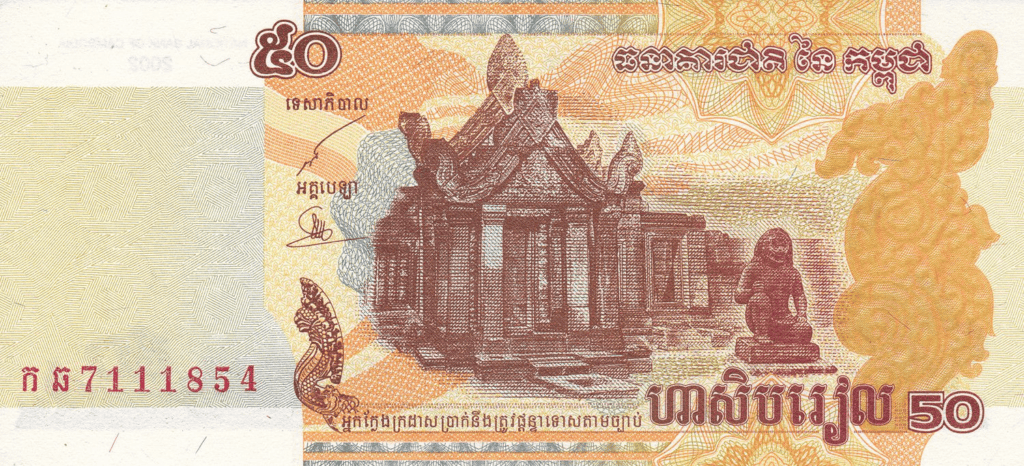
The 50 riel note with Banteay Srei on the obverse and a dam on the reverse, in dark brown and tan, issued on 29 August 2002.
100៛
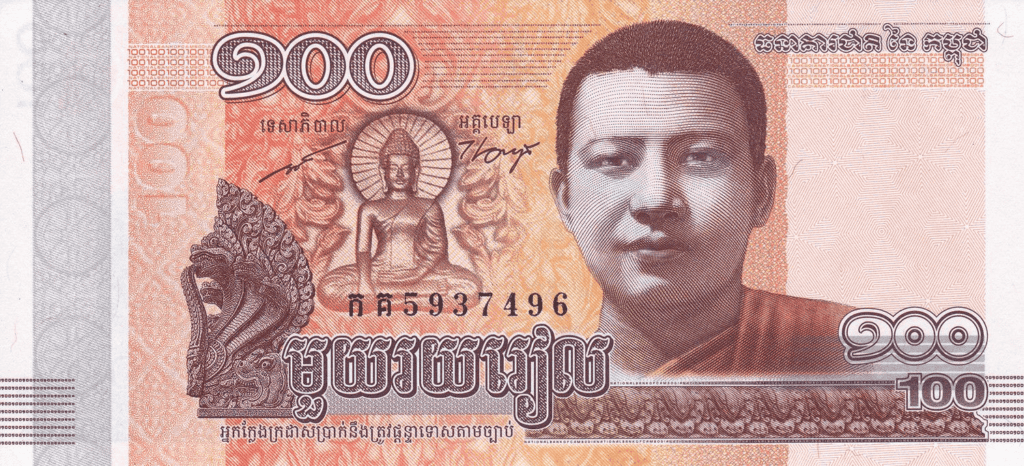
The 100 riel notes have two versions; one issued on 9 August 2001, featuring the Independence Monument and a school, in purple, brown, and green, and another issued on 14 January 2015, depicting a Naga head, Buddha, and King Father Norodom Sihanouk, with a Khmer statue on the reverse, in orange and brown.
200៛
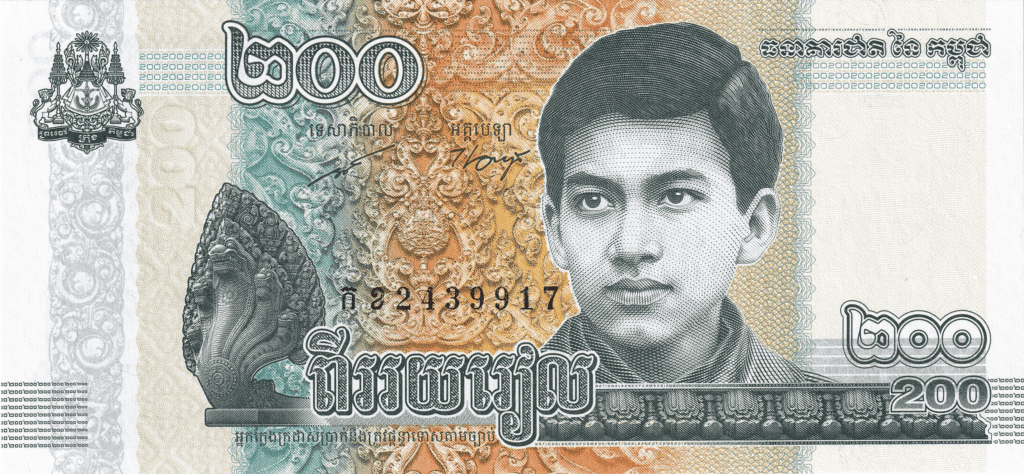
The 200 riel note issued on 14 November 2022 showcases the Royal arms of Cambodia and King Norodom Sihamoni on the obverse, and Preah Thineang Chan Chhaya on the reverse, in gray, green, and orange.
500៛
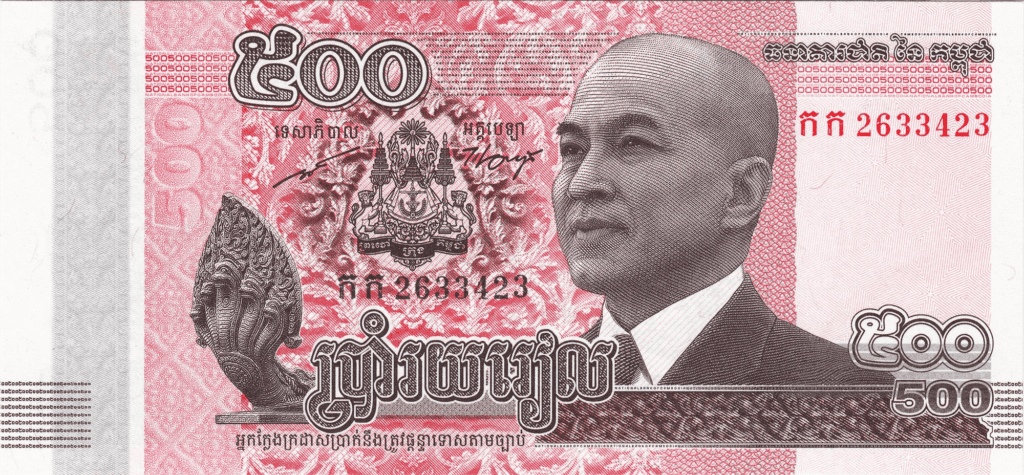
The 500 riel notes include a version from 4 April 2003 with Angkor Wat and the Kizuna bridge, in red and purple, and a 2014 issue with a Naga head and King Norodom Sihamoni, in red, pink, and gray.
1,000៛
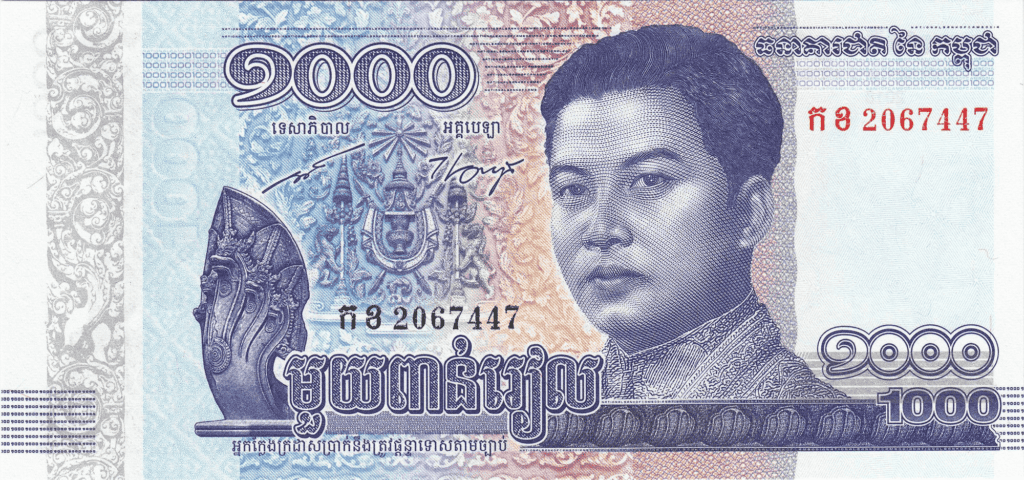
The 1,000 riel notes have three versions: one from 6 January 2006 with the Southern gate at Bayon, a 2012 issue with a Naga head and Royal Arms of Cambodia, and a 2016 version featuring a Naga head and King Norodom Sihanouk, in varying colors.
2,000៛
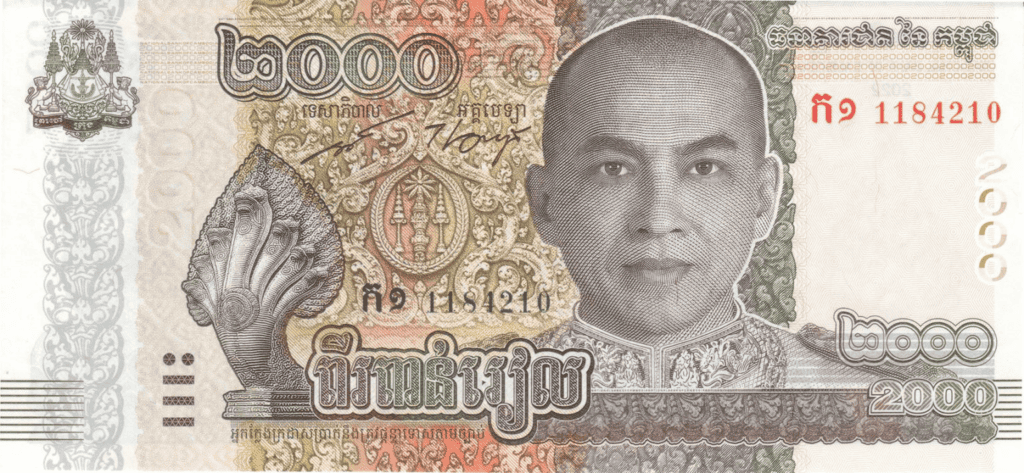
The 2,000 riel notes come in versions from 2008, 2013, and 2022, with themes ranging from Prasat Preah Vihear to the Independence Monument, all in shades of green.
5,000៛
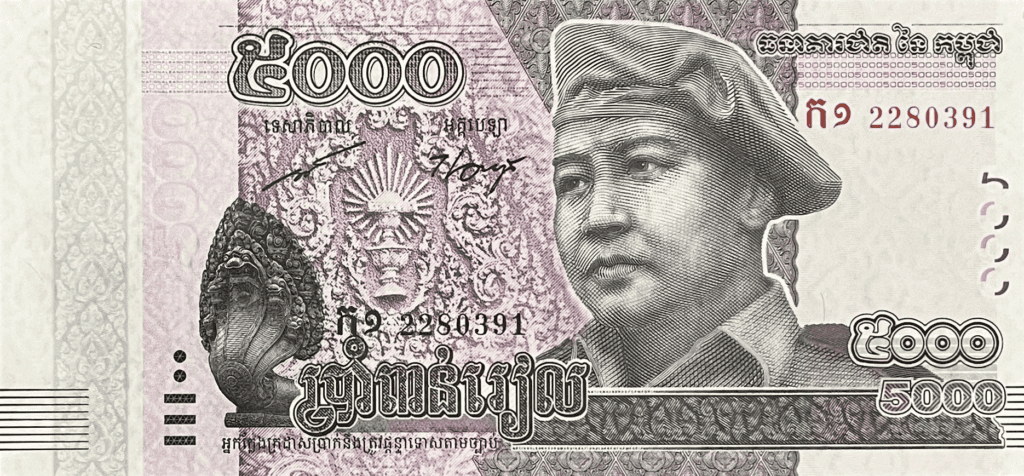
The 5,000 riel notes include a 2001 issue with King Norodom Sihanouk and a 2015 version featuring a Naga head and King Norodom Sihanouk wearing a beret, in green and gray, and violet and brown, respectively.
10,000៛
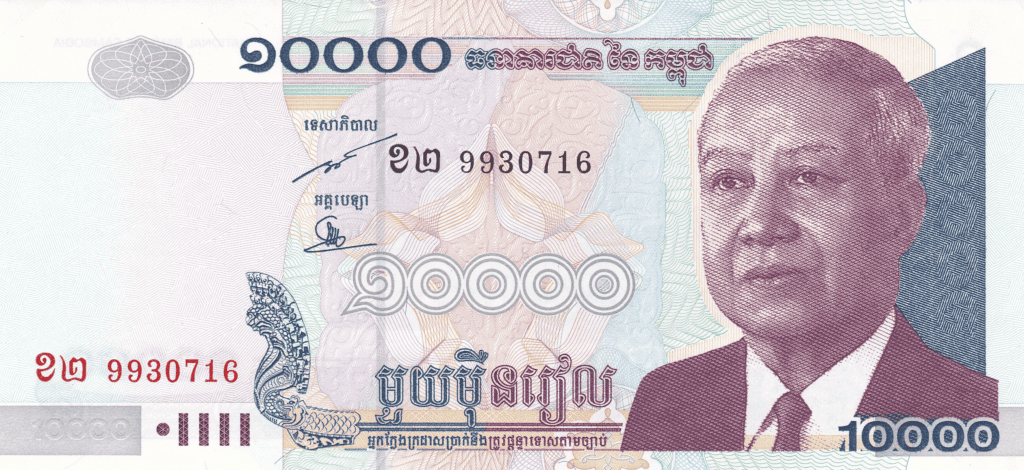
The 10,000 riel notes from 2001 and 2015 showcase King Norodom Sihanouk and King Norodom Sihamoni, with designs in violet, brown, and blue, and blue.
15,000៛
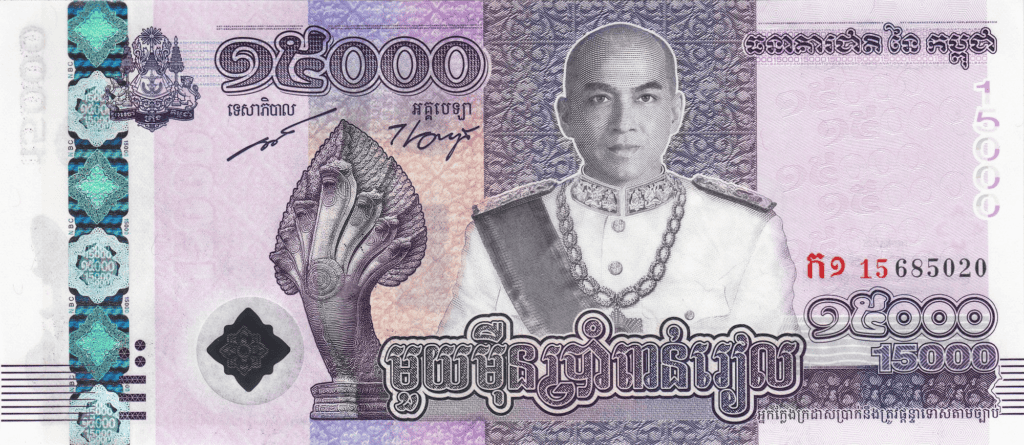
The 15,000 riel note, introduced in 2019, showcases King Norodom Sihamoni and a seven-headed naga on a purple background, celebrating the coronation of Norodom Sihamoni and the Win-Win Memorial.
20,000៛
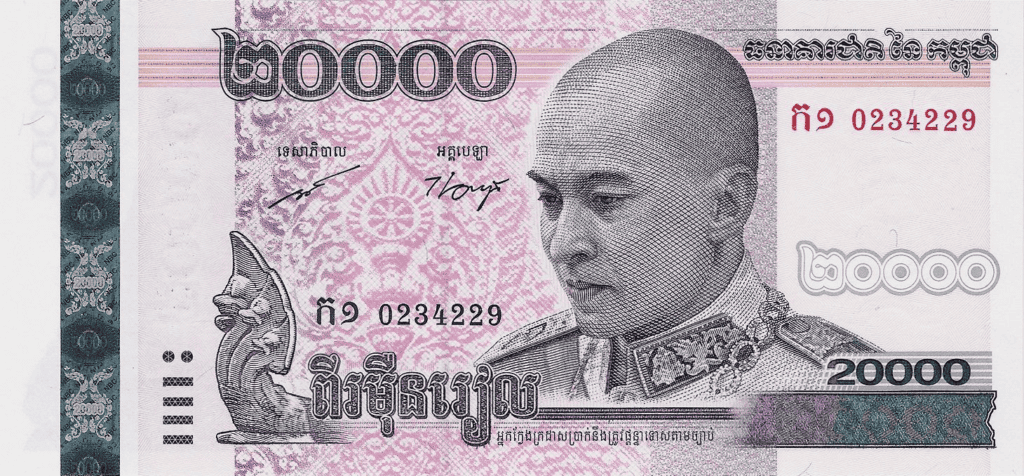
Two versions of the 20,000 riel note exist: one issued in 2008 with King Norodom Sihamoni and Angkor Wat, and another in 2017, displaying a naga and the Banteay Srei Temple, both featuring violet and purple hues as well as light and dark pink and gray.
30,000៛

The 30,000 riel note, released in 2021, highlights a naga and King Norodom Sihanouk against a backdrop of the Royal Palace and international landmarks, in green, brown, and purple.
50,000៛
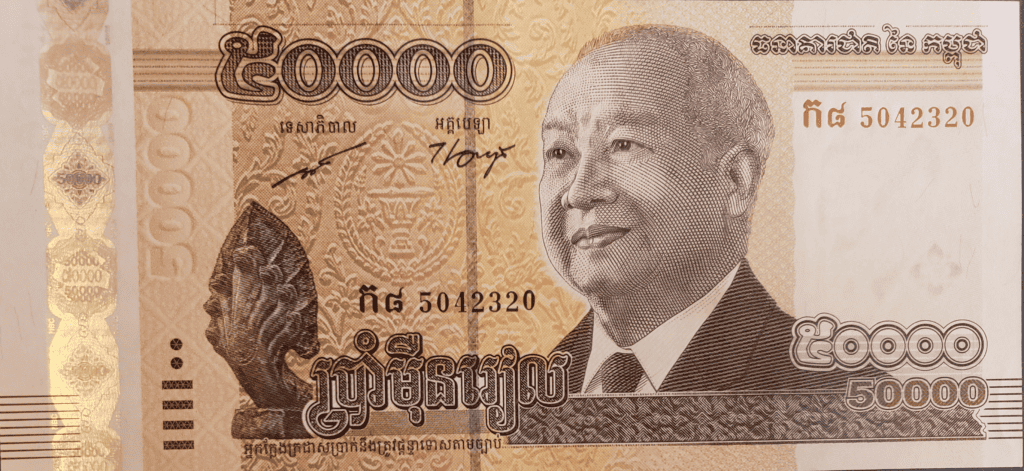
Two 50,000 riel notes were issued, one in 2001 featuring Norodom Sihanouk and Angkor Wat, and another in 2013 with a naga and the Bakong Temple, in violet, brown, and blue, and brown, respectively.
100,000៛

The highest denomination, the 100,000 riel note, introduced in 2012, depicts the Royal Arms of Cambodia and the royal family, set against a green background, symbolizing Cambodia’s rich royal heritage and cultural significance.
Each banknote reflects Cambodia’s rich history, culture, and significant figures, with specific colors and motifs that represent various aspects of the nation’s heritage.
Currency Usage in Cambodia
If you are planning a trip to Cambodia, it is essential to know about the country’s currency usage. The official currency in Cambodia is the Cambodian riel (KHR), but US dollars (USD) are widely accepted as well.
Is USD accepted in Cambodia?
Yes, USD is accepted in Cambodia, and it is the unofficial second currency. Most tourist places even quote prices in USD, which includes restaurants, tours, and long-distance buses. If you’re following the typical Cambodia itinerary, you’ll stay within the tourist zone, where USD is widely accepted.
However, it is essential to carry small denominations of USD as most places do not accept large bills. You can exchange your USD to KHR at any bank or money exchange place. The exchange rate is around 4000 KHR to 1 USD, but it may vary depending on where you exchange your money.
When you arrive in Cambodia, you will need to pay for your visa in USD. The visa on arrival costs 30 USD, and you must have the exact amount in cash. Therefore, it is advisable to carry enough USD with you to cover your visa fee and other expenses until you can exchange your money.
Exchanging Currency in Cambodia
When traveling to Cambodia, it’s important to have an understanding of the local currency and where to exchange it. Here are some things to keep in mind when exchanging currency in Cambodia.
Where can I exchange Cambodia currency?
You can exchange your currency at banks, exchange offices, and hotels throughout Cambodia. Banks are generally the most reliable and secure option, but they may have longer wait times. Exchange offices and hotels may offer more convenience but may have higher fees and less favorable exchange rates.
To find the best exchange rates, it’s recommended to shop around and compare rates at several different locations before exchanging your currency. Additionally, it’s important to make sure that the exchange office or bank is licensed and reputable.
What to know before exchanging currency in Cambodia
Before exchanging your currency in Cambodia, there are a few things to keep in mind. Firstly, it’s important to know the current exchange rate for the Cambodian riel and the US dollar. As of February 2024, the exchange rate is approximately 4,000 riel to 1 US dollar.
Secondly, it’s recommended to bring US dollars in cash as they are widely accepted in Cambodia and can be used for most transactions. However, it’s important to note that US dollars with any markings or tears may not be accepted.
Third, one thing to keep in mind is that Cambodia has a cash-based economy, so it’s important to have enough cash on hand for your daily expenses. While credit cards are accepted at some hotels and restaurants, they may not be accepted at smaller businesses or markets. ATMs are also readily available in larger cities, but they may not be available in more rural areas.
Lastly, it’s important to count your money carefully before leaving the exchange office or bank. Make sure that you have received the correct amount and that the bills are not counterfeit or damaged.
By following these tips, you can exchange your currency safely and efficiently while traveling in Cambodia.
Choosing Between USD and Cambodia Currency
When traveling to Cambodia, you’ll have to decide whether to use US dollars or Cambodian riel for your transactions. Here are some factors to consider before making your decision.
Exchange Rate
The exchange rate between US dollars and Cambodian riel fluctuates, but generally, one US dollar is equivalent to around 4,000 Cambodian riel.
While some establishments may accept US dollars, it’s important to note that most places quote prices in Cambodian riel. As such, you may end up paying more if you use US dollars due to the exchange rate.
Convenience
Using US dollars is generally more convenient for tourists since it’s a widely accepted currency in Cambodia. You can easily withdraw US dollars from ATMs or exchange them at banks or money changers.
However, do note that smaller establishments may not accept US dollars and may only accept Cambodian riel.
Fees
When withdrawing US dollars from ATMs, you may be charged a withdrawal fee by your bank and an additional fee by the local bank. These fees can add up, so it’s important to check with your bank before traveling to Cambodia.
Additionally, when exchanging US dollars for Cambodian riel, some money changers may charge a commission or offer unfavorable exchange rates.
Tips
When paying with US dollars, it’s important to note that Cambodian riel coins are often used as change. As such, it’s advisable to carry some Cambodian riel coins on hand to avoid receiving too much change in coins. Additionally, it’s customary to tip in Cambodian riel rather than US dollars.
In summary, while using US dollars may be more convenient for tourists, it’s important to consider the exchange rate and potential fees. It’s also important to carry some Cambodian riel on hand for smaller transactions and tipping.
Cost of Living in Cambodia
If you are planning to move to Cambodia or even just visiting, it is important to have an idea of the cost of living in the country.
The cost of living in Cambodia is generally lower than in many other countries, including the United States. However, the cost of living can vary depending on your lifestyle, location, and other factors.
According to Numbeo, a single person’s estimated monthly costs are around $590.8 without rent. The cost of living in Cambodia is, on average, 47.5% lower than in the United States. Rent in Cambodia is, on average, 77.4% lower than in the United States.
One of the biggest expenses in Cambodia is housing. The cost of housing can vary depending on the location and type of housing. In Phnom Penh, the capital city, the cost of housing is generally higher than in other parts of the country. However, even in Phnom Penh, you can find affordable housing options.
Food is generally affordable in Cambodia, especially if you eat like a local. Street food is a popular and cheap option, with dishes such as noodle soup, fried rice, and stir-fried vegetables costing around $1-2. Eating at mid-range restaurants can cost around $5-10 per meal.
Transportation in Cambodia is also affordable. Tuk-tuks are a popular mode of transportation and can cost around $1-2 for a short ride. Motorbikes are also a common way to get around and can be rented for around $5-10 per day.
Overall, the cost of living in Cambodia is generally lower than in many other countries. However, it is important to keep in mind that the cost of living can vary depending on your lifestyle and location.
Don’t Get Scammed Tips
When traveling to Cambodia, it’s important to be aware of potential scams when dealing with currency. Here are some tips to help you avoid being scammed:
1. Be aware of fake currency
Cambodia is known for having a high rate of counterfeit currency, especially US dollars. To avoid being scammed, make sure to inspect your bills carefully before accepting them. Look for signs of wear and tear, as well as watermarks and security threads. If you’re unsure about a bill, don’t be afraid to ask for another one.
2. Use reputable money changers
When exchanging currency, it’s important to use reputable money changers to avoid being scammed. Avoid exchanging money on the street or in small shops, as these are often fronts for illegal money changers. Instead, use banks or reputable exchange offices, and make sure to compare rates before making a transaction.
3. Don’t fall for ATM scams
ATM scams are common in Cambodia, so it’s important to be vigilant when using them. Always cover the keypad when entering your PIN, and make sure to use ATMs located inside banks or other secure locations. If an ATM looks suspicious or has any signs of tampering, don’t use it.
4. Be cautious of overcharging
Some vendors in Cambodia may try to overcharge tourists, especially when it comes to currency exchange. To avoid being scammed, make sure to know the current exchange rates before making a transaction. You can also use a currency converter app on your phone to double-check the rates.
5. Keep your currency secure
Finally, it’s important to keep your currency secure when traveling in Cambodia. Avoid carrying large amounts of cash, and use a money belt or other secure method to store your currency. Be aware of your surroundings, especially in crowded areas, and never leave your currency unattended.
By following these tips, you can avoid being scammed when dealing with currency in Cambodia.

